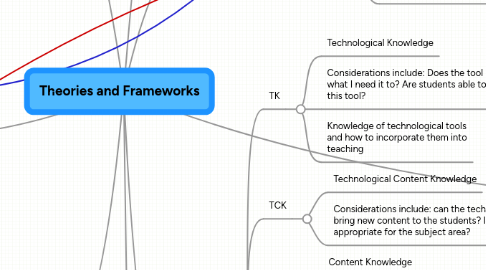
1. Behaviourism
1.1. Teacher Directed/Direct Instruction
1.2. Stimulus -> something happens in the brain -> learning
1.3. Drill and practice
1.4. Reinforcement and punishment
1.5. Extrinsic motivation
1.6. Modelling, shaping, cuing
1.7. Lecture
1.8. Applied behaviour analysis
1.9. Technologies include: iClickers, Mad Minutes, TED Talks, Math Blasters
2. Cognitivism
2.1. Somewhat Teacher Directed
2.2. stimulus -> ideas are assimilated in existing schemas and accommodated as new schemas are built -> learning
2.3. Practice is important
2.4. Ideal to work in the zone of proximal development or ZPD (pushing students beyond what they can do easily ex: learning to ride a bike)
2.5. Organization is key; Mnemonics, mind maps, chunking, other organizers
2.6. Memory is made up of: sensory memory, working (short-term) memory, and long-term memory; memory can be under-stimulated or overstimulated
2.7. Technologies Include: Mindmeister, Prezi, learning management systems (eClass)
3. Cognitive Load Theory
3.1. There are only so many things that the working memory can hold at one time
3.2. Processing too much information too fast can overload the working memory ex: lots of jargon or learning in a second language
3.3. Organization can make a big difference with cognitive overload
4. Constructivism
4.1. Student Directed
4.2. Students construct their own learning by interacting with their environment
4.3. The teacher acts as a facilitator or guide
4.4. Model of inquiry
4.5. Problem, case-based or project based learning allows for students to decide what (within parameters) and how to learn, and how to show what they've learned
4.6. Authentic (relevant to real-world) tasks
4.7. Discovery learning (student has what they need - materials and background knowledge- to find the answer, guided by teacher)
4.8. Is collaborative because other people make up the "environment" with which students are interacting with to construct their knowledge
4.9. Working in the ZPD is key
4.10. Technologies include blogging websites, ePortfolios, video games, and lego robotics.
5. Connectivism
5.1. Student Directed and technology driven
5.2. Is focused on building networks of knowledge rather than gaining knowledge
5.3. Being able to access the information you need is more imporant than actually knowing it
5.4. Currency - up to date, accurate knowledge - is the driving force
5.5. Technologies include Pinterest, social media (Facebook, twitter etc.), Evernote, search engines (Google), email, skype etc.
6. Theories of Technology
6.1. Media Ecology
6.1.1. Technology influences society
6.1.2. very broad, all encompasing (vague) definition - is the study of environments
6.1.3. The way we use technology affects us as a people - interactions, understanding, how we make snese of the world, etc.
6.1.4. Technology is part of everything we do
6.2. Social Construction of Technology (SCOT)
6.2.1. Society influences technology
6.2.1.1. society influences the success of technology
6.2.1.2. what becomes mainstream technology is determined by society
6.2.1.3. society constructs what and how technology is meaningful
7. TPACK
7.1. TK
7.1.1. Technological Knowledge
7.1.2. Considerations include: Does the tool do what I need it to? Are students able to use this tool?
7.1.3. Knowledge of technological tools and how to incorporate them into teaching
7.2. TCK
7.2.1. Technological Content Knowledge
7.2.2. Considerations include: can the technological tool bring new content to the students? Is the tool appropriate for the subject area?
7.3. CK
7.3.1. Content Knowledge
7.3.2. What is the teacher's knowledge of the content?
7.3.3. What is the student's knowledge of the content?
7.3.4. Considerations include: background knowledge, scaffolding, has what has been taught enough?
7.4. PCK
7.4.1. Pedagogical content knowledge(how to teach a specific subject)
7.4.2. one consideration: are the pedagogical strategies appropriate to the content I am teaching?
7.5. PK
7.5.1. Pedagogical knowledge (how to teach)
7.5.2. Considerations include: are the activities engaging? Am i teaching in a variety of ways to reach all students? Am I providing students with a variety of ways to show what they have learned?
7.6. TPK
7.6.1. Technological Pedagogical Knowledge
7.6.2. Use of technology to teach
7.6.3. Considerations include: What are the advantages and disadvantages of the tool in teaching? Is the tool effective in reaching all students in the class?
8. Philosophy of Teachnology
8.1. Is one's philosophy of technology in teaching
8.2. Is necessary in the 21st century to help form modern citizens out of students
8.3. Just like a philosophy of teaching, teachers can come up with written statements about their philosophy of teachnology
8.4. Statements could include themes such as...
8.4.1. accessibility to technology
8.4.2. digital responsibility should be taught
8.4.3. technology can and should promote higher order thinking
8.4.4. technology can provide new access to learning
8.4.5. special needs should be considered: technology used in activities needs to be accessible to all students with special needs
8.4.5.1. Technology can also make learning activities more accessible to students with special needs
